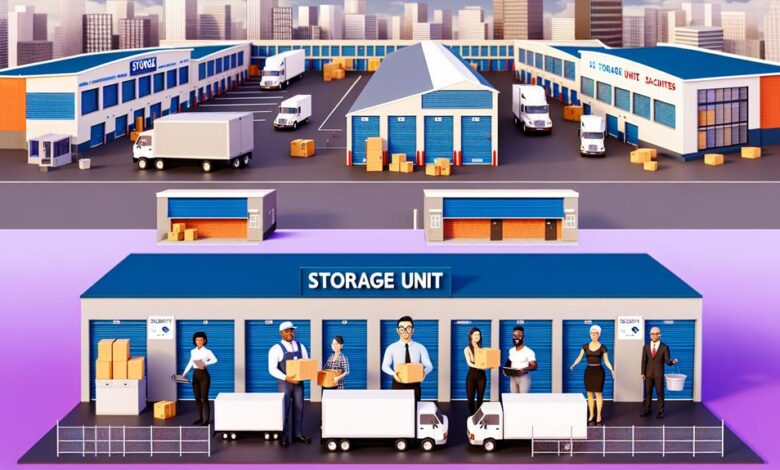How to Find Local Storage Units for Your Needs

When you’re trying to find local storage units that suit your needs, start by evaluating what you plan to store and the size of the unit required. You’ll want to consider the location’s convenience and the security measures in place. Begin your search by researching local options, paying close attention to reviews and operating hours. It’s crucial to compare prices and features across different facilities to get the best value. But how do you ensure the facility meets your standards for cleanliness and security? Let’s explore the essential steps to make a confident decision.
Assess Your Storage Needs
When looking for a storage unit, it’s crucial to first assess your storage needs to ensure you select the right size and type of unit. Start by inventorying the items you plan to store. Are you storing furniture, appliances, or smaller personal items? This will help you determine the appropriate storage size. Units range from small lockers to large garage-sized spaces. Be realistic about the space you’ll need to avoid paying for unused space or cramming everything into too small a unit.
Consider the location. Proximity to your home or business can make frequent visits more convenient. If you need regular access, a closer location is ideal. However, if you don’t need to visit often, a slightly farther location might offer better rates.
Next, prioritize security measures. Look for units with robust physical security, such as gated access, surveillance cameras, and individual unit alarms. These features can protect your belongings from theft or damage.
Accessibility is another key factor. Check the unit’s hours of operation and ease of access—drive-up units are more accessible than those inside a building with limited access hours.
Research Local Options
After assessing your storage needs, the next step is to research local options to find the best fit. Begin by focusing on location proximity. Look for storage units close to your home or workplace to make accessing your belongings convenient. Use online maps or directories to identify nearby facilities, and don’t hesitate to visit a few to get a firsthand view of their accessibility.
Next, prioritize facility security. A secure storage unit ensures peace of mind. Check for features like gated access, surveillance cameras, and on-site staff. These elements are crucial in protecting your items from theft or damage. Verify if the facility has individual unit alarms or advanced security systems.
Additionally, read online reviews and ask for recommendations. Customer feedback can provide insights into the reliability and trustworthiness of a storage facility. Pay attention to comments about the cleanliness and overall condition of the units, as these factors can affect the preservation of your belongings.
Lastly, inquire about the facility’s operation hours. Ensure they align with your schedule, allowing you to access your items when needed. By thoroughly researching these aspects, you’ll be well on your way to finding a local storage unit that meets your requirements.
Compare Prices and Features
Start by obtaining quotes from at least three different storage facilities to get a clear picture of the pricing landscape. This initial step lets you make a detailed budget comparison, ensuring you know the range of prices. Look beyond just the monthly rental fee; pay attention to any hidden costs like administrative fees, insurance, or late payment penalties.
Next, focus on amenities evaluation. Examine what each facility offers. Is 24/7 access important to you? Some units offer climate control, which is essential for sensitive items like electronics or antiques. Others might provide enhanced security features such as surveillance cameras, gated access, or on-site managers. You’ll want to weigh these amenities against their costs to see what provides the best value for your needs.
Don’t forget to ask about any promotional deals or discounts. Some facilities offer the first month free or reduced rates for long-term commitments. These can significantly impact your budget comparison, making a pricier option more affordable in the long run.
Visit Potential Facilities
You’ve compared prices and features, and now it’s time to get a firsthand look at your options by visiting potential storage facilities. Start by scheduling visits to a few top contenders on your list. When you arrive, take note of the facility cleanliness. A well-maintained site usually indicates good management and can prevent issues like pests and mold. Look for clean floors, properly sealed units, and no visible trash.
Next, evaluate the security measures in place. Check for surveillance cameras, sturdy fencing, and secure access points. Are there electronic gates with unique entry codes? This can significantly reduce unauthorized access.
Additionally, ask about on-site personnel – having staff present can deter potential theft and provide immediate assistance if needed.
While you’re there, assess the overall environment. Is it well-lit at night? Good lighting enhances security and makes late visits safer. Don’t hesitate to ask the manager about any specific security protocols they follow.
Also, inquire about their policies regarding insurance for stored items.
Read Customer Reviews
When choosing a storage unit, it’s crucial to read customer reviews to gain insights that mightn’t be evident during a visit. Review sites like Yelp, Google Reviews, and Trustpilot are invaluable resources for gathering firsthand experiences from other customers. These platforms offer a wealth of information about the facility’s cleanliness, customer service, and overall reliability.
Start by looking at the overall rating and then dive into the individual testimonials. Pay close attention to recurring themes in both positive and negative reviews. If multiple reviews mention issues like poor security or unhelpful staff, consider these red flags.
Conversely, consistent praise for cleanliness and customer service can be reassuring.
Don’t just stick to the review sites. Ask friends, family, or colleagues for their recommendations. Personal testimonials often provide nuanced perspectives that online reviews may miss. Additionally, some storage facilities feature customer testimonials on their websites. While these are usually positive, they can still offer useful insights.
Secure Your Storage Unit
After gathering insights from customer reviews, the next step is to ensure your storage unit is secure. Start by choosing a facility that offers robust security measures. Look for storage units equipped with a sturdy key lock or, even better, a keyless entry system. Modern facilities often feature 24/7 surveillance cameras to deter unauthorized access and monitor activity around the clock.
In addition to physical security, consider environmental factors. A unit with climate control can protect your belongings from temperature fluctuations and humidity, which is particularly important for sensitive items like electronics, documents, and furniture. Check if the facility has alarms installed. These can alert staff and law enforcement in the event of a break-in, providing an extra layer of security.
Also, inquire about the facility’s access hours. Limited access hours can reduce the risk of theft. Make sure the area is well-lit, and pathways are clear.
Don’t forget to ask about the facility’s maintenance routine; a well-maintained property indicates a responsible management team.
Conclusion
In conclusion, finding the right local storage unit comes down to thorough research and careful consideration. Remember, “an ounce of prevention is worth a pound of cure.” Assess your storage needs, compare prices, and don’t forget to visit each facility to gauge security and cleanliness. Reading customer reviews will give you valuable insights. By taking these steps, you’ll ensure your belongings are safe and well-stored, giving you peace of mind. Happy storing!
Keep an eye for more news & updates on UsaTechMagazine!





